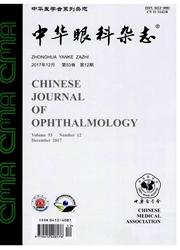

 中文摘要:
中文摘要:
AIM:To survey the prevalence and causes of visual impairment/blindness among elderly Chinese from different socioeconomic status in community-based design.METHODS:Cluster-sampling randomly selected residents from Binhu and Funing District,two areas representing different socioeconomic levels in China with Binhu in an advanced status and Funing in lessdeveloped area.The participants subjected to ophthalmic examination.The presenting visual acuity(PVA) and best-corrected visual acuity(BCVA) were recorded.Visual impairment and blindness were defined according to World Health Organization criteria.The causes of visual impairment/blindness were identified by ophthalmic examination and/or questionnaire.The socioeconomic status included the per capita gross domestic product,numbers of hospital with ophthalmic service and the number of ophthalmologists per 1 million residents.RESULTS:We successfully included 12 867 participants form 2 areas in this study.The prevalence of PVA impairment(<20/63 to ≥20/400) in the better eye was 5.4% in Binhu and 23.6% in Funing,while the prevalence of blindness(<20/400) was 0.9% in Binhu and 2.3% in Funing.With BCVA,the prevalence of visual impairment was 2.4% in Binhu and 6.4% in Funing,while the prevalence of blindness was 0.8% in Binhu and 1.6% in Funing.The participants with older age and female gender had higher prevalence in visual impairment and blindness.The highest prevalences of vision impairment and blindness evaluated by BCVA at >80y age group reached 20.4% and 6.3% respectively.The prevalences of vision impairment and blindness evaluated by BCVA were 3.5% and 1.0% in male and 5.0% and 1.3% in female.The above differences were statistically significant(P<0.05).The predominant causes of visual impairment and blindness were cataract,retinal disorders and uncorrected refractive error in both areas.The socioeconomic status was associated with visual impairment and blindness.CONCLUSION:This community-based study build a sufficient sample size for an ophthalmic survey.Our data sho
 英文摘要:
英文摘要:
AIM:To survey the prevalence and causes of visual impairment/blindness among elderly Chinese from different socioeconomic status in community-based design.METHODS:Cluster-sampling randomly selected residents from Binhu and Funing District,two areas representing different socioeconomic levels in China with Binhu in an advanced status and Funing in lessdeveloped area.The participants subjected to ophthalmic examination.The presenting visual acuity(PVA) and best-corrected visual acuity(BCVA) were recorded.Visual impairment and blindness were defined according to World Health Organization criteria.The causes of visual impairment/blindness were identified by ophthalmic examination and/or questionnaire.The socioeconomic status included the per capita gross domestic product,numbers of hospital with ophthalmic service and the number of ophthalmologists per 1 million residents.RESULTS:We successfully included 12 867 participants form 2 areas in this study.The prevalence of PVA impairment(〈20/63 to ≥20/400) in the better eye was 5.4% in Binhu and 23.6% in Funing,while the prevalence of blindness(〈20/400) was 0.9% in Binhu and 2.3% in Funing.With BCVA,the prevalence of visual impairment was 2.4% in Binhu and 6.4% in Funing,while the prevalence of blindness was 0.8% in Binhu and 1.6% in Funing.The participants with older age and female gender had higher prevalence in visual impairment and blindness.The highest prevalences of vision impairment and blindness evaluated by BCVA at 〉80y age group reached 20.4% and 6.3% respectively.The prevalences of vision impairment and blindness evaluated by BCVA were 3.5% and 1.0% in male and 5.0% and 1.3% in female.The above differences were statistically significant(P〈0.05).The predominant causes of visual impairment and blindness were cataract,retinal disorders and uncorrected refractive error in both areas.The socioeconomic status was associated with visual impairment and blindness.CONCLUSION:This community-based study build a sufficient sample size f
 同期刊论文项目
同期刊论文项目
 同项目期刊论文
同项目期刊论文
 期刊信息
期刊信息
